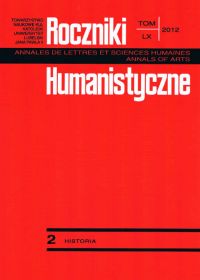„Bo Honor Twój Biskupi, zaszczytem jest Prześwietnej Familii Szeptyckich”. Inicjatywy biskupów Cerkwi unickiej z rodziny Szeptyckich podnoszące prestiżu rodu w XVIII wieku
Abstrakt
In the 18th century, the Szeptycki family gave the Uniate Church four bishops: Barłaam Bazyli, Atanazy Antoni, Ludwik Leon, Atanazy Andrzej. The Episcopal dignity gave them a chance to foster the prestige of their family. In order to achieve this goal, the bishops used religious celebrations and festivities to as an arena in which they produced their message with the use of all means of communication known to the world of that era. Through the diversity of their appeal, they were able to reach all social layers. In their methodology of proclaiming the prestige of the family, the bishops used panegyric texts and artefacts of material culture, which they made full of genealogical and heraldic references. These initiatives allowed the bishops to sustain the position of their family on a local scale, as borne out by the official titles of some of the members of the family. However, the bishops failed in gaining any influence at the royal court. Although the main focus of all these activities was on elevating the social status of the family, the bishops’ actions influenced directly the change within the Uniate Church. Through their reliance on methods and means of communication which imitated the model developed by the Nobles and the Roman Catholic Church, the Uniate bishops brought their Church to the realm of Latin civilization.
Bibliografia
Baranowski A. J., Koronacje wizerunków maryjnych w czasach baroku. Zjawisko kulturowe i artystyczne, Warszawa 2003.
Baranowski A. J., Rola rodzin magnackich w osiemnastowiecznych uroczystościach koronacyjnych na wschodnich terenach Rzeczypospolitej, w: Sztuka ziem wschodnich Rzeczypospolitej XVI-XVIII w., red. J. Lileyko, Lublin 2000.
Betlej A., Sibi, Deo, Posteritati. Jabłonowscy a sztuka w XVIII wieku, Kraków 2010.
Krasny P., Architektura cerkiewna na ziemiach ruskich Rzeczypospolitej, Kraków 2003.
Krasny P. Katedra Św. Jura we Lwowie a tradycyjna architektura cerkiewna Rusi Czerwonej, w: Sztuka kresów wschodnich, t. V, red. A. Betlej, P. Krasny, Kraków, 2003.
Nabywaniec S., Antoni Angełłowicz [1756-1814] i Michał Lewicki [1774-1858], pierwsi greckokatoliccy metropolici halicko-lwowscy, „Resovia Sacra” 3(1996).
Nabywaniec S., Unicka archidiecezja kijowska w okresie rządów arcybiskupa metropolity Felicjana Filipa Wołodkowicza 1762-1778, Rzeszów 1998.
Skoczylas I., Sobory eparchii chełmskiej XVII wieku. Program religijny Slavia Unita wRzeczypospolitej, przeł. A. Gil, Lublin 2008.
Скочиляс I., Собори Львивської эпархії XVI-XVIII ст., Львiв 2006.
Śliwa T., Greckokatolicki biskup łucki Stefan Lewiński (1736-1807), „Premislia Christiana” 10 (2003).
Zielińska T., Propaganda świetności domu radziwiłłowskiego, epoki Michała K. Radziwiłła „Rybeńki” w ówczesnych „środkach masowego przekazu”, w: Między Wschodem a Zachodem. Rzeczpospolita XVI-XVIII w. Studia ofiarowane Zbigniewowi Wójcikowi w siedemdziesiątą rocznicę urodzin, red. T. Chynczewska-Hennel, Warszawa 1993.
Copyright (c) 2012 Roczniki Humanistyczne

Utwór dostępny jest na licencji Creative Commons Uznanie autorstwa – Użycie niekomercyjne – Bez utworów zależnych 4.0 Międzynarodowe.





